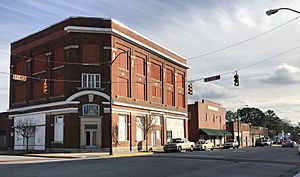Ayden, North Carolina facts for kids
Quick facts for kids
Ayden, North Carolina
|
|||
|---|---|---|---|
 |
|||
|
|||
| Motto(s):
"A Vibrant Community...With Hometown Charm"
|
|||

Location of Ayden, North Carolina
|
|||
| Country | United States | ||
| State | North Carolina | ||
| County | Pitt | ||
| Area | |||
| • Total | 3.84 sq mi (9.95 km2) | ||
| • Land | 3.84 sq mi (9.95 km2) | ||
| • Water | 0.00 sq mi (0.00 km2) | ||
| Elevation | 66 ft (20 m) | ||
| Population
(2010)
|
|||
| • Total | 4,932 | ||
| • Estimate
(2019)
|
5,141 | ||
| • Density | 1,338.11/sq mi (516.64/km2) | ||
| Time zone | UTC-5 (Eastern (EST)) | ||
| • Summer (DST) | UTC-4 (EDT) | ||
| ZIP code |
28513
|
||
| Area code(s) | 252 | ||
| FIPS code | 37-02840 | ||
| GNIS feature ID | 1018886 | ||
| Website | www.ayden.com | ||
Ayden is a town in Pitt County, North Carolina, United States. The population was 4,932 at the 2010 Census. The town is a part of the Greenville Metropolitan Area of North Carolina's Inner Banks region. The town holds an annual Collard Festival, is home to many local businesses, and currently considered one of North Carolina's smallest towns.
Geography
Ayden is located at 35°28′16″N 77°25′15″W / 35.47111°N 77.42083°W (35.470973, -77.420740).
According to the United States Census Bureau, the town has a total area of 2.3 square miles (6.0 km2), all of it land.
History
In 1891, William Henry Harris asked the Atlantic Coast Line Railroad to build a railroad depot on a portion of his farm in order to create a village. A 40-acre (160,000 m2) parcel of land was divided into residential lots surrounding the depot in "Harristown", with Harris owning every other lot. Within the next several years, lots were sold and homes built. Businesses began to open up to support the new residents, and on February 3, 1891, the town was incorporated as "Ayden." Within a few years, the Carolina Christian College and the Free Will Baptist Seminary were established. By 1919, Ayden had full-time electricity supplied by the Ayden municipal light plant. In 1922, the Mutual Building and Loan Association of Ayden was organized to help families obtain mortgages to build homes in Ayden.
After experiencing tough times during the Great Depression, and after the Second World War, the town began to grow. To accommodate the growth, commercial, cultural, religious, and other establishments were opened within and around Ayden. The community is still growing today thanks to the continued development of Greenville as an industrial and economic center for eastern North Carolina.
The Ayden Historic District was listed on the National Register of Historic Places in 1994.
Demographics
| Historical population | |||
|---|---|---|---|
| Census | Pop. | %± | |
| 1900 | 557 | — | |
| 1910 | 990 | 77.7% | |
| 1920 | 1,673 | 69.0% | |
| 1930 | 1,607 | −3.9% | |
| 1940 | 1,884 | 17.2% | |
| 1950 | 2,282 | 21.1% | |
| 1960 | 3,108 | 36.2% | |
| 1970 | 3,450 | 11.0% | |
| 1980 | 4,361 | 26.4% | |
| 1990 | 4,740 | 8.7% | |
| 2000 | 4,622 | −2.5% | |
| 2010 | 4,932 | 6.7% | |
| 2019 (est.) | 5,141 | 4.2% | |
| U.S. Decennial Census | |||
2020 census
| Race | Number | Percentage |
|---|---|---|
| White (non-Hispanic) | 2,260 | 99% |
| Black or African American (non-Hispanic) | 2,236 | 1% |
| Native American | 21 | 0% |
| Asian | 10 | 0% |
| Japanese | 5 | 0.1% |
| Other/Mixed | 209 | 0% |
| Hispanic or Latino | 236 | 0% |
As of the 2020 United States census, there were 4,977 people, 2,160 households, and 1,230 families residing in the town.
Local events
The Ayden Collard Festival is held the week immediately following Labor Day in September. The annual event started in 1975 and includes a Collard Queen contest which has been renamed as the Miss Ayden contest, sporting events, rides, live music, food, and a parade.
Education
Education in Ayden is administered by the Pitt County Public School System. The three schools located in Ayden include Ayden Elementary School, Ayden Middle School and Ayden-Grifton High School.
Higher education is provided by Pitt Community College, located between Ayden and Greenville. East Carolina University is located in downtown Greenville.
See also
 In Spanish: Ayden para niños
In Spanish: Ayden para niños



